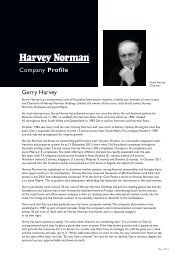annual report - Harvey Norman Company Reports & Announcements
annual report - Harvey Norman Company Reports & Announcements
annual report - Harvey Norman Company Reports & Announcements
You also want an ePaper? Increase the reach of your titles
YUMPU automatically turns print PDFs into web optimized ePapers that Google loves.
STATEMENT OF SIGNIFICANT ACCOUNTING POLICIES (CONTINUED)<br />
(xv) Employee benefits<br />
Provision is made for benefits accruing to employees in respect of wages and salaries, <strong>annual</strong> leave and long service leave<br />
when it is probable that settlement will be required and they are capable of being measured reliably.<br />
Provisions made in respect of employee benefits expected to be settled within 12 months, are measured at their nominal<br />
values using the remuneration rate expected to apply at the time of settlement. Provisions made in respect of employee<br />
benefits which are not expected to be settled within 12 months are measured as the present value of the estimated future<br />
cash outflows to be made by the consolidated entity in respect of services provided by employees up to <strong>report</strong>ing date.<br />
Consideration is given to expected future wage and salary levels, experience of employee departures, and periods of<br />
service. Expected future payments are discounted using market yields at the <strong>report</strong>ing date on national government bonds<br />
with terms to maturity and currencies that match, as closely as possible, the estimated future cash outflows.<br />
Defined contribution plans<br />
Contributions to defined contribution superannuation plans are expensed when incurred.<br />
(xvi) Share-based payment transactions<br />
The consolidated entity provides benefits to certain employees (including executive directors) of the consolidated entity in<br />
the form of share-based payment transactions, whereby employees render services in exchange for shares or rights over<br />
shares (“equity-settled transactions”).<br />
The cost of these equity-settled transactions with employees is measured by reference to the fair value at the date at which<br />
they are granted. The fair value is determined by an external valuer either using a binomial valuation methodology or Black<br />
Scholes-Merton valuation methodology. The cost of equity-settled transactions is recognised, together with a<br />
corresponding increase in equity, over the period in which the performance conditions are fulfilled, ending on the date on<br />
which the relevant employees become fully entitled to the award (“vesting date”).<br />
The cumulative expense recognised for equity-settled transactions at each <strong>report</strong>ing date until vesting date reflects (i) the<br />
extent to which the vesting period has expired and (ii) the number of awards that, in the present opinion of the directors of<br />
the consolidated entity, will ultimately vest. This opinion is formed based on the best available information at balance date.<br />
No adjustment is made for the likelihood of market performance conditions being met as the effect of these conditions is<br />
included in the determination of fair value at grant date. No expense is recognised for awards that do not ultimately vest,<br />
except for awards where vesting is conditional upon a market condition.<br />
The dilutive effect, if any, of outstanding options is reflected as additional share dilution in the computation of earnings per<br />
share.<br />
If an equity-settled award is cancelled, it is treated as if it had vested on the date of cancellation, and any expense not yet<br />
recognised for the award is recognised immediately. However, if a new award is substituted for the cancelled award and<br />
designated as a replacement award on the date that it is granted, the cancelled and new award are treated as if they<br />
were a modification of the original award.<br />
(xvii) Leases<br />
Consolidated entity as lessor<br />
Amounts due from lessees under finance leases are recorded as receivables. Finance lease receivables are initially<br />
recognised at amounts equal to the present value of the minimum lease payments receivable plus the present value of any<br />
unguaranteed residual value expected to accrue at the end of the lease term. Finance lease payments are allocated<br />
between interest revenue and reduction of the lease receivable over the term of the lease in order to reflect a constant<br />
periodic rate of return on the net investment outstanding in respect of the lease.<br />
Rental income from operating leases is recognised on a straight line basis over the term of the relevant lease.<br />
Consolidated entity as lessee<br />
Finance leases, which transfer to the consolidated entity substantially all the risks and benefits incidental to ownership of the<br />
leased item, are capitalised at the inception of the lease at the fair value of the leased property or, if lower, at the present<br />
value of the minimum lease payments. Lease payments are apportioned between the finance charges and reduction of<br />
the lease liability so as to achieve a constant rate of interest on the remaining balance of the liability.<br />
65



